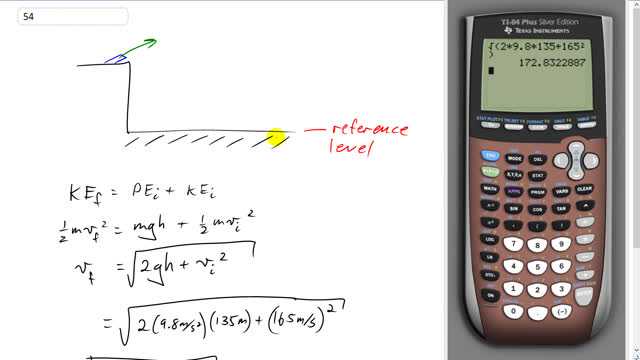
A projectile is fired at an upward angle of from the top of a 135-m-high cliff with a speed of 165 m/s. What will be its speed when it strikes the ground below? (Use conservation of energy.)

In order to watch this solution you need to have a subscription.
This is Giancoli Answers with Mr. Dychko. Here's a picture of what's going on with this projectile being launched upwards at some angle from the top of this cliff and then it's gonna land on the ground and the question is, "what speed will it have when it gets to ground?" We'll take the ground to be the reference level, which means we are measuring our height when we are calculating gravitational potential energy, with respect to this ground level, which means that on the ground, there would be zero height and so there would be zero gravitational potential energy. And so, on this side of the equation for the total final energy, there's only kinetic energy and that total is gonna equal the total initial energy, which consists of both potential because it's some distance above the ground on this cliff plus some kinetic energy because it has some initial velocity. You are gonna see that the angle, of it's being launched at, doesn't matter and that makes using energy conservation an easier technique for solving this question than what we did in chapter 3, where we used, you know, vertical and horizontal components of velocity, and so on. Here there's no component business at all. We are gonna substitute for each of this things; so we have final kinetic energy is one-half m v final squared equals mg times height plus one-half m v initial squared; multiply everything by 2, divide everything by m and take the square root of both sides and you get the final speed at the ground equals square root of 2 g times the height of the cliff plus v initial squared. So that's square root of 2 times 9.8 meters per second squared times 135 meters plus 165 meters per second squared which gives 173 meters per second is the final speed, at the ground.
Why did you multiply everything by 2?
@p.zepplin, multiplying by "2" is an algebra step to remove the from the left side in order to isolate .
Cheers,
Mr. Dychko
If you work this problem using the kinematic formulas, I get an answer of 113.87 m/s. When I use the vertical component of the initial velocity with the kinetic energy formula, I also get an answer of 113.87 m/s. So how do you justify ignoring the angle at which the projectile is fired?